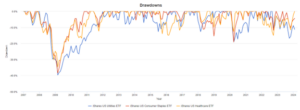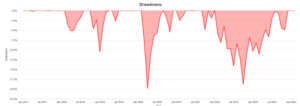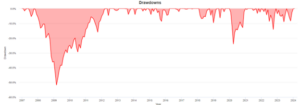“People want to believe that this time is different, that there’s something new under the sun, and through their own ingenuity they can wish risk away.” – Seth Klarman, CEO of Baupost Group
I was attempting to uncover how a prospective client felt about money, risk, and investing.
After contemplating my questions, the new retiree across the table leaned over, let out a deep breath, and uttered…
“I want my assets to grow, but I want them to be safe.”
Growth and safety.
Separately, the mission is straightforward…
Growth – we invest in the stock market, which has a track record of going up over time. We understand stocks are risky assets, with periods of losses, drawdowns, and uncomfortable moments.
Safety – we invest in cash equivalents (money market, CD’s, high-yield savings, etc.) and earn a modest return while protecting our initial investment. We sleep well at night knowing the risk of loss is small.
Things get complicated when we attempt to achieve growth and safety. In the context of investing, can those two things exist together?
We evaluate the “safest” equity asset classes on our quest to see if growth and safety can co-exist.
Defensives: Utilities, Staples, and Healthcare
In good times and bad times, people need heat, electricity, toilet paper, and healthcare. The thesis is these ‘defensive’ equity asset classes should hold up regardless of what the economy is doing.

Source: Portfoliovisualizer.com
The above chart shows drawdown for the iShares US Utilities ETF (blue), iShares US Consumer Staples ETF (red), and iShares US Healthcare ETF (yellow) from 2007 to 2023. These sectors might provide some downside shelter against broad market sell-offs, however, 20%-40% drawdowns would hardly meet the definition of “safe”.
It would seem defensive equity sectors do not pass the ‘growth and safety’ test.
Low Volatility Factor
Low volatility factor investing targets stocks that exhibit less price movement relative to other stocks. That’s a fancy way of saying stocks that move less up and down.

Source: Portfoliovisualizer.com
The above graph shows drawdown for the Fidelity Low Volatility Factor ETF (2017 – 2023). Most investors wouldn’t classify a -20% drawdown as safe (or even low volatility).
High Dividend Paying Stocks
In my 20+ years as a professional investor, I don’t think there is a bigger misconception than the idea that dividend paying stocks are “safe”. I could argue that a high dividend paying stock is one of the riskiest assets out there…

Source: Portfoliovisualizer.com
The above graph shows drawdown for the Vanguard High Dividend Yield ETF (2007 – 2023). High dividend payers experienced a brutal drawdown of over 50% in 2008-2009. Buying a stock for the high dividend yield under the guise of “safety” is like picking up pennies in front of a steam roller.
Can the ideas of growth and safety co-exist in an investment strategy?
- The goal of growth and safety does not exist in investing. Marrying the two is a recipe for disappointment.
- Investors should build a portfolio that reflects their risk profile and realistic return assumptions. For example, an investor might be willing to accept the occasional 15% drawdown for the opportunity to achieve a 6.5% annualized return over the long term.
- Historically “safe” equity asset classes i.e. defensives, low volatility, and dividend payers can experience large drawdowns of 20% or more.
- An investor can’t achieve portfolio growth without bearing some risk of loss. However, over the long term, there is evidence to suggest equities are a safer asset class than most perceive (see “This is Why We Invest: Long-Term View on Markets“).
- If an investor wants more safety and less risk, they can find money market funds, CDs, or high-yield savings accounts. The tradeoff is sacrificing growth that outpaces inflation.
The idea of, “I want my assets to grow, but I don’t want to lose money” as a style of investing is unattainable and does not exist. A more sound approach is to build a portfolio that mirrors your tolerance for pain. This allows an investor to generate reasonable returns over the longest period of time.
In my opinion, growth and safety should never be uttered in the same sentence.
Have a question or feedback? Shoot us a note at insight@pureportfolios.com
